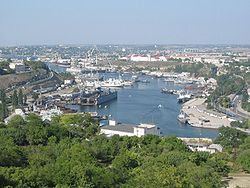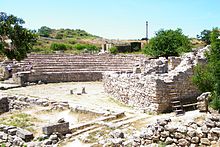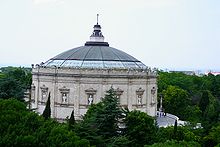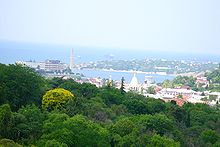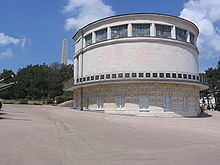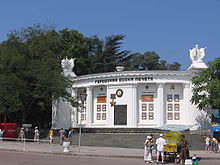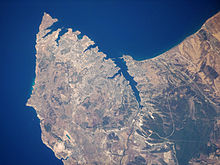- Sevastopol
-
Sevastopol
Севастополь
AqyarView of Sevastopol 
Flag
Coat of armsMap of Ukraine with Sevastopol highlighted Coordinates: 44°36′0″N 33°31′48″E / 44.6°N 33.53°ECoordinates: 44°36′0″N 33°31′48″E / 44.6°N 33.53°E Country  Ukraine
UkraineMunicipality Sevastopol Municipality City Sevastopol Founded 1783 Government – City Governor Vladimir Grigorievich Yatsuba Area – Total 864 km2 (333.6 sq mi) Elevation 100 m (328 ft) Population (2007) – Total 379,200 – Density 438.89/km2 (1,136.7/sq mi) Time zone EET (UTC+2) – Summer (DST) EEST (UTC+3) Postal code 99000—99699 Area code(s) +380-692 License plate CH Decorations _ 



Website http://sev.gov.ua/en/ Sevastopol (
 /ˌsɛvəˈstoʊpəl/ or /səˈvæstəpoʊl/; previously Sebastopol; Ukrainian and Russian: Севастополь; Crimean Tatar: Aqyar) is a city on rights of administrative division of Ukraine, located on the Black Sea coast of the Crimea peninsula. It has a population of 342,451 (2001).[1] Sevastopol is the second largest port in Ukraine, after the Port of Odessa.
/ˌsɛvəˈstoʊpəl/ or /səˈvæstəpoʊl/; previously Sebastopol; Ukrainian and Russian: Севастополь; Crimean Tatar: Aqyar) is a city on rights of administrative division of Ukraine, located on the Black Sea coast of the Crimea peninsula. It has a population of 342,451 (2001).[1] Sevastopol is the second largest port in Ukraine, after the Port of Odessa.The unique geographic location and navigation conditions of the city's harbours make Sevastopol a strategically important naval point. It is also a popular seaside resort and tourist destination, mainly for visitors from the Commonwealth of Independent States (CIS) countries. The city, formerly the home of the Russian then Soviet Black Sea Fleet, is now home to a Ukrainian naval base and a Russian naval base in facilities leased by the Russian Navy. The headquarters of both the Ukrainian Naval Forces and Russia's Black Sea Fleet are located in the city. In 1993, the city was the subject of a territorial dispute between the Russian Federation and Ukraine.
The trade and shipbuilding importance of Sevastopol's port has been growing since the fall of the Soviet Union,[citation needed] despite the difficulties that arise from the joint military control over its harbours and piers. Sevastopol is also an important centre of marine biology research. In particular, studying and training of dolphins has been conducted in the city since the end of World War II. It was first conducted as a secret naval programme to use the animals for special undersea operations. Sevastopol enjoys one of the warmest climates in Ukraine, with mild winters and moderate warm summers.
Contents
Etymology
The name of Sevastopolis (Modern Greek: Σεβαστούπολη, Sevastoupoli, old-fashioned Σεβαστούπολις, Sevastoupolis), or currently Sevastopol, was originally chosen in the same etymological trend as other cities in the Crimean peninsula that was intended to reflect its ancient Greek origins. It is a compound of two Greek nouns, σεβαστός (sebastós, Modern sevastós) ('venerable') and πόλις (pólis) ('city'). Σεβαστός is the traditional Greek translation of the honourable Roman title Augustus ('venerable'), originally given to the first emperor of the Roman Empire, G. Julius Caesar Octavianus and later awarded as a title to his successors.
Despite its Greek origin, the name is not old. The city was probably named after the Empress ("Augusta") Catherine II of Russia who founded Sevastopol in 1783. She visited the city in 1787 accompanied by Joseph II, the Emperor of Austria, and other foreign dignitaries.
In the west of the city, there are well-preserved ruins of an ancient Greek port city of Chersonesos, founded in the 5th century BC. The name means "peninsula" reflecting its location and is not related to the ancient Greek name for the Crimean Peninsula, Chersonēsos Taurikē ("the Taurian Peninsula").
Orthography and pronunciation of the name
- In English, the current prevalent spelling of the name is Sevastopol. The spelling Sebastopol was also formerly used. In English it is
 /ˌsɛvəˈstoʊpəl/ or /səˈvæstəpoʊl/.
/ˌsɛvəˈstoʊpəl/ or /səˈvæstəpoʊl/. - Ukrainian and Russian: Севастополь, pronounced [seβ̞ɑsˈtɔpɔlʲ] in Ukrainian and [sʲɪvɐsˈtopəlʲ] in Russian.
- Crimean Tatar: Aqyar
- Turkish: Akyar and Sivastopol
- Modern Greek: Σεβαστούπολη Sevastoupoli
Political status and subdivision
Administratively, Sevastopol is a municipality excluded from the surrounding Autonomous Republic of Crimea (see Administrative divisions of Ukraine for more details). The territory of the municipality is 863.5 km²[2] and it is further subdivided into four raions (districts). Besides the City of Sevastopol proper, it also includes two towns — Balaklava, Inkerman, urban-type settlement Kacha, and 29 villages.
Sevastopol has no elected mayor, instead a "Chairman of the Sevastopol City State Administration" functions as a mayor.[3] She/he is appointed by the President of Ukraine.[3]
Climate
City enjoys one of the warmest climates in Ukraine, with mild winters and moderate warm summers. Sevastopol has a humid subtropical climate (Köppen climate classification: Cfa)[4] near the borderline of the humid continental climate and the semi-arid climate.
The average yearly temperature is 15–16 °C (59–61 °F)} during the day and around 9 °C (48 °F) at night. In the coldest months – January and February – the average temperature is 5–6 °C (41–43 °F) during the day and around 1 °C (34 °F) at night. In the warmest months – July and August – the average temperature is around 26 °C (79 °F) during the day and around 19 °C (66 °F) at night. Generally – summer's/holiday season lasts to 5 months, starting from around mid-May and ending in September, however, also in the first half of October quite often temperature reaches 20 °C (68 °F) or more. From June to September - the average sea temperature is =>20 °C (68 °F), while in the second half of May and first half of October - the average sea temperature is about 17 °C (63 °F). The average rainfall is about 400 millimetres (16 in) per year and there is about 2,200 hours of sunshine duration per year.
Climate data for Sevastopol Month Jan Feb Mar Apr May Jun Jul Aug Sep Oct Nov Dec Year Average high °C (°F) 5.9
(42.6)6.0
(42.8)8.9
(48.0)13.6
(56.5)19.2
(66.6)23.5
(74.3)26.5
(79.7)26.3
(79.3)22.4
(72.3)17.8
(64.0)12.3
(54.1)8.1
(46.6)15.9 Daily mean °C (°F) 2.9
(37.2)2.8
(37.0)5.5
(41.9)9.9
(49.8)15.2
(59.4)19.5
(67.1)22.4
(72.3)22.1
(71.8)18.2
(64.8)13.9
(57.0)8.9
(48.0)5.1
(41.2)12.2 Average low °C (°F) −0.2
(31.6)−0.4
(31.3)2.0
(35.6)6.1
(43.0)11.1
(52.0)15.5
(59.9)18.2
(64.8)17.9
(64.2)13.9
(57.0)9.9
(49.8)5.4
(41.7)2.0
(35.6)8.5 Precipitation mm (inches) 26
(1.02)25
(0.98)24
(0.94)27
(1.06)18
(0.71)26
(1.02)32
(1.26)33
(1.3)42
(1.65)32
(1.26)42
(1.65)52
(2.05)379
(14.92)Source: svali.ru[5] Climate data for Sevastopol Month Jan Feb Mar Apr May Jun Jul Aug Sep Oct Nov Dec Year Average high °C (°F) 5
(41)6
(43)8
(46)13
(55)18
(64)23
(73)25
(77)25
(77)21
(70)16
(61)12
(54)8
(46)15 Daily mean °C (°F) 3
(37)3
(37)6
(43)10
(50)15
(59)20
(68)22
(72)22
(72)18
(64)13
(55)9
(48)5
(41)12 Average low °C (°F) 2
(36)2
(36)3
(37)8
(46)12
(54)17
(63)19
(66)19
(66)15
(59)10
(50)6
(43)3
(37)10 Precipitation mm (inches) 39
(1.54)34
(1.34)30
(1.18)26
(1.02)26
(1.02)38
(1.5)33
(1.3)31
(1.22)40
(1.57)28
(1.1)47
(1.85)54
(2.13)426
(16.77)Source: meteoprog.ua[6] History
Sevastopol together with Kronstadt and Gibraltar is one of the most famous naval citadels in Europe.[citation needed] It was founded in 1783 by Rear Admiral Makenzie, in Russian service, as a base for a naval squadron, when Russia annexed the Crimean peninsula. Five years earlier, Aleksandr Suvorov ordered that earthworks be erected along the harbour and Russian troops be located there. At first, the place was called by its ancient name, Akhtiar. In February 1784, Catherine II (the Great) ordered Grigory Potyomkin (Grigoriy Potemkin) to build a fortress there and call it Sevastopol. The realisation of the initial building plans fell to Captain F.F. Ushakov, in 1788 named commander of the port and of the Black Sea squadron.[7][8] It became an important naval base and later a commercial port. In 1797 under an edict issued by Emperor Paul I, the military stronghold was renamed Akhtiar. Finally, on April 29 (May 10), 1826, the Senate returned the city's name to Sevastopol.
One of the most notable events involving the city is the Siege of Sevastopol (1854–1855) carried out by the British, French, Sardinian, and Turkish troops during the Crimean War, which lasted for 11 months. Despite its efforts, the Russian army had to leave its stronghold and evacuate over a pontoon bridge to the north shore of the inlet. The Russians had to sink their entire fleet to prevent it from falling into the hands of the enemy and at the same time to block the entrance of the Western ships into the inlet. When the enemy troops entered Sevastopol, they were faced with the ruins of a formerly glorious city.
A panorama of the siege originally was created by Franz Roubaud. Later after its destruction in 1942 during WWII, it was restored and is being housed in a specially constructed circular building in the city. It portrays the situation in the height of the siege, on 18 June 1855.
During World War II, Sevastopol withstood intensive bombardment by the Germans in 1941–1942, during the Axis siege which lasted for 250 days before it fell in July 1942. The city was intended to be renamed to "Theodorichshafen" in case of a German victory against the Soviet Union, and like the rest of the Crimea was designated for future colonization by the Third Reich. It was liberated by the Red Army on May 9, 1944 and was awarded with the Hero City title a year later.
In 1957, the town of Balaklava was incorporated into Sevastopol.
During the Soviet era, Sevastopol, became a so-called "closed city". This meant that any non-residents had to apply to the authorities for a temporary permit to visit the city. It was directly subordinate to the central Russian SFSR authorities rather than the local oblast and later (after 1978) to the Ukrainian SSR administration.[9]
On December 11, 1992, the President of Ukraine called the attempt of "the Russian deputies to charge the Russian parliament with a task to define the status of Sevastopol as an imperial disease". On December 17, 1992, the office of the Ukrainian presidential representative in [Crimea was created, which caused a wave of protests a month later. Among the protesters who organised the unsanctioned rally were the Sevastopol branches of the National Salvation Front, the Russian Popular Assembly, and the All-Crimean Movement of the Voters for the Republic of Crimea. The protest was held in Sevastopol on January 10 at the Nakhimov Square.
On July 10, 1993, the Russian parliament passed a resolution declaring Sevastopol to be "a federal Russian city". At the time, many supporters of the president, Boris Yeltsin, had ceased taking part in the Parliament's work.[10]
On April 14, 1993, the Presidium of the Crimean Parliament called for the creation of the presidential post of the Crimean Republic. A week later, the Russian deputy, Valentin Agafonov, stated that Russia is ready to supervise the referendum on Crimean independence and include the republic as a separate entity in the CIS. On July 28, 1993, one of the leaders of the Russian Society of Crimea, Viktor Prusakov, stated that his organisation was ready for an armed mutiny and establishment of the Russian administration in Sevastopol. In September, Eduard Baltin accused Ukraine of converting some of his fleet and conducting an armed assault on his personnel, and threatened to take countermeasures of placing the fleet on alert. In May 1997, Russia and Ukraine signed the Peace and Friendship Treaty, ruling out Moscow's territorial claims to Ukraine.[11]
Like in the rest of the Crimea, Russian remains the predominant language in the city, although following the independence of Ukraine there have been some attempts at Ukrainization with very little success. The administration from the Government of Ukraine retains formal control of Sevastopol's life (such as of taxation and police) and tries to avoid confrontation with the Black Sea Fleet command and pro-Russian groups. A few years ago, the city council, dominated by the Communist Party of Ukraine, rejected a European Bank for Reconstruction and Development loan to renovate Sevastopol's poor sewage system, declaring that the project was intended to increase the city's dependence on the Ukrainian government and the Western world.[citation needed]
The WE Youth Political Organization, which advocates Russian citizenship for Sevastopol residents,[12] published a poll in 2004 claiming "72% of the Sevastopol citizens support the idea of the independent status of Crimea. The Crimea is an autonomous Republic within Ukraine. Besides, 95% of the respondents support the constant stationing of the Russian Black Sea Fleet in Sevastopol even after 2045, when the time of the corresponding agreement between Russia and Ukraine is up. Also, 100% of those polled are for the having the option for citizens of Sevastopol of dual citizenship, Russian and Ukrainian. It is notable, however, that of those expressing a desire to be able to obtain Russian citizenship only 16% of the Sevastopol citizens are ready to give up the Ukrainian one."[13]
Sights and monuments
After World War II, Sevastopol was entirely rebuilt. Many top architects and civil engineers from Moscow, Leningrad, Kiev and other cities and thousands of workers from all parts of the USSR took part in the rebuilding process which was mostly finished by the mid-1950s. The downtown core situated on a peninsula between two narrow inlets, South Bay and Artillery Bay, features mostly Mediterranean-style, three-story residential buildings with columned balconies and Venetian-style arches, with retail and commercial spaces occupying the ground level. Some carefully restored landmarks date back to the early 20th c. (e.g., the Art Nouveau Main Post Office on Bolshaya Morskaya St and the Art Museum on Nakhimovsky Prospect). It has been a long-time tradition for the residents of surrounding suburbs to spend summer evenings by coming to the downtown area for a leisurely stroll with their families along the avenues and boulevards encircling the Central Hill, under the famous Sevastopol chestnut trees, and usually ending up on the waterfront with its famous Marine Boulevard.
Due to its military history, most streets in the city are named after Russian and Soviet military heroes. There are hundreds of monuments and plaques in various parts of Sevastopol commemorating its military past.
Attractions list
- Chersonessos National Archeological Reserve
- The Panorama Museum (The Heroic Defence of Sevastopol during the Crimean War)
- Malakhov Kurgan (Barrow) with its White Tower
- Admirals' Burial Vault
- The Sunken Ships Monument on the Marine Boulevard
- The Black Sea Fleet Museum
- The Storming of Sapun-gora of May 7, 1944, the Diorama Museum (World War II)
- Fraternal (Communal) War Cemetery
Architecture
There are many historical buildings in the central and eastern parts of the city and Balaklava, some of which are architectural monuments. The Western districts have modern architecture. More recently, numerous skyscrapers have been built. Balaklava Bayfront Plaza, currently under construction, will be one of the tallest buildings in Ukraine, at 173 m (568 ft) with 43 floors.[14]
Demographics
The population of Sevastopol proper is 342,451 (2001), making it the 15th largest city in Ukraine and the largest in Crimea. City agglomeration has population 961,885 (2008). According to the Ukrainian National Census, 2001, the ethnic groups of Sevastopol include Russians (71.6%), Ukrainians (22.4%), Belarusians (1.6%), Tatars (0.7%), Crimean Tatars (0.5%), Armenians (0.3%), Jews (0.3%), Moldovans (0.2%), and Azerbaijanis (0.2%).[15]
Government
 1. Gagarin Raion (pink)
1. Gagarin Raion (pink)
2. Lenin Raion (red)
3. Nakhimov Raion (blue)
4. Balaklava Raion (light green)
5. Inkerman (green)The city of Sevastopol is part of the Sevastopol Municipality (Ukrainian: міськрада, Russian: горсовет) which has a special status within Ukraine and has a total area of around 863.5 square kilometres (333.4 sq mi). Unlike the rest of the cities in the country Sevastopol officially does not have a typical mayor due to its status, functions of which conducts the head of Sevastopol Municipality State Administration or a city governor appointed by the President of Ukraine. The local administration is represented by the city's council headed by its chairman.
The Sevastopol Municipality is divided into four municipal raions: Lenin Raion, Nakhimov Raion, Gagarin Raion, and Balaklava Raion. Out of settlements beside Sevastopol, the municipality also contains 29 rural settlements including villages as well as two urban settlements: the Inkerman City and the town of Kacha. All of the settlements are organized within the municipal raions. Most of the Sevastopol City is located within Lenin and Gagarin raions, with Lenin being the central one and housing the administrations of city and municipality.
Economy
Apart from navy-related civil facilities, Sevastopol hosts some other notable industries, such as "Phiolent" — Ukraine's largest power tools manufacturer and Stroitel one of the leading plastics manufacturers in Ukraine.
Transport
There are 7 types of transport in Sevastopol:
- Bus - 337 routes
- Trolleybus - 19 routes
- Minibus - 52 routes
- Cutter - 18 routes
- Ferry - 2 routes
- Express-bus - 15 routes
- HEV-train[clarification needed] - 1 route
According to the 1997 treaty, a Russian naval base would continue to be located in Sevastopol and the adjoining region on the terms of a 20-year renewable lease, following a long diplomatic and political dispute between Russia and the newly independent Ukraine.
Following the breakup of the Soviet Union, Moscow refused to recognise Ukrainian sovereignty over Sevastopol as well as over the surrounding Crimean oblast, using the argument that the city was never practically integrated into the Ukrainian Soviet Socialist Republic because of its military status. This claim was relinquished in the bilateral Peace and Friendship Treaty, which confirmed that both the Crimea and Sevastopol belong to Ukraine. A separate treaty established the terms of a long-term lease of land and resources in and around Sevastopol by Russia.
The ex-Soviet Black Sea Fleet and its facilities, was divided between Russia's Black Sea Fleet and the Ukrainian Navy. The two navies now co-use some of the city's harbours and piers, while others were demilitarised or used by either country. Sevastopol remains the location of the Russian Black Sea Fleet headquarters with the Ukrainian Naval Forces Headquarters also based in the city. A judicial row periodically continues over the naval hydrographic infrastructure both in Sevastopol and on the Crimean coast (especially lighthouses historically maintained by the Soviet or Russian Navy and also used for civil navigation support).
The status of the Black Sea Fleet has a strong influence over the city's business and cultural life. The Russian society in general and even some outspoken government representatives have never accepted the loss of Sevastopol and tend to regard it as temporarily separated from the homeland.[16] In 2008, Moscow Mayor Yuriy Luzhkov declared that Sevastopol "should again be a Russian city" and appropriated $34 million for "the support of compatriots abroad."[17] Protests by citizens of the city caused the cancellation of a joint Ukraine-NATO military exercise in 2006.[17]
In July 2009, the chairman of the Sevastopol city council, Valeriy Saratov (Party of Regions)[18] stated that Ukraine should increase the amount of compensation it is paying to the city of Sevastopol for hosting the foreign Russian Black Sea Fleet, instead of requesting such obligations from the Russian government and the Russian Ministry of Defense in particular.[19]
On April 27, 2010, Russia and Ukraine ratified the Russian Ukrainian Naval Base for Gas treaty, extending the Russian Navy's lease of the Sevastopol base for 25 years after 2017 (through 2042) with an option to prolong the lease for another 5 years (through 2047). The ratification process in the Ukrainian parliament encountered stiff opposition and erupted into a brawl in the parliament chamber. Eventually, the treaty was ratified by a 52% majority vote - 236 to 450. The Russian Duma ratified the treaty by a 98% majority without incident.[20]
See also
- 2121 Sevastopol - an asteroid discovered in 1971 by Soviet astronomer Tamara Mikhailovna Smirnova and named after the city.[21]
- Sevastopol is the name for a township located in Wisconsin, United States.
- Sevastopol Shipyard
- Port of Sevastopol
Gallery
-
Ships of the Black Sea Fleet in Sevastopol
References
- ^ "GeoHive: Country Data: Ukraine". Xist.org. 2009-07-01. http://www.xist.org/cntry/ukraine.aspx. Retrieved 2010-04-26.
- ^ Area 1079 km² including water
- ^ a b (Russian) Як Янукович скасував вибори мера Севастополя, Ukrayinska Pravda (August 30, 2010)
- ^ "World Map of Köppen−Geiger Climate Classification". http://www.schweizerbart.de/resources/downloads/paper_free/55034.pdf.
- ^ "Севастополь, Крым, Украина - Описание, путеводитель, туры, авиабилеты, достопримечательности, отели, климат, фото, карта, погода". http://www.svali.ru/catalog~91~33991~index.htm.
- ^ "METEOPROG.UA: Клімат Севастополь". http://www.meteoprog.ua/ua/climate/Sevastopol/.
- ^ "Основание и развитие Севастополя". Sevastopol.info. 2007-05-28. http://www.sevastopol.info/history/hist_first.htm. Retrieved 2010-04-26.
- ^ Wikipedia Russian language version
- ^ The Warsaw Voice, "Fleeting Disagreements", 1996
- ^ Russian Parliament Votes a Claim to Ukrainian Port of Sevastopol, The New York Times (July 10, 1993)
- ^ People.com, December 28, 2005
- ^ "The Open Letter to Pres. Putin on Citizenship for Sevastopol". WE Youth Political Organization. 2007-10-29. http://wana.crimea.ua/site/en/news/latest/6.html. Retrieved 2008-08-10.
- ^ "72% of the Sevastopol citizens support the idea of the independent Crimea". WE Youth Political Organization. October 2004. http://wana.crimea.ua/site/en/news/interviews/72.html. Retrieved 2008-08-10.
- ^ "Balaklava Bayfront Plaza, Sevastopol". SkyscraperPage.com. http://skyscraperpage.com/cities/?buildingID=82259. Retrieved 2010-04-26.
- ^ "2001 Ukrainian census". Ukrcensus.gov.ua. http://www.ukrcensus.gov.ua/eng/results/general/nationality. Retrieved 2010-04-26.
- ^ Pravda.com.ua (in Ukrainian)
- ^ a b Russia's Next Target Could Be Ukraine by Leon Aron, Wall Street Journal, September 10, 2008
- ^ Calm sea in Sevastopol, Kyiv Post (September 4, 2009)
- ^ Sevastopol authorities asking to raise compensation fees for Russian Black Sea Fleet's basing, Kyiv Post (July 28, 2009)
- ^ BBC World: "Parliamentary chaos as Ukraine ratifies fleet deal." 27 April 2010
- ^ Schmadel, Lutz D. (2003). Dictionary of Minor Planet Names (5th ed.). New York: Springer Verlag. p. 172. ISBN 3-540-00238-3. http://books.google.com/books?q=2121+Sevastopol+1971+ME.
External links
- sev.gov.ua - Official website (English)/(Ukrainian)/(Russian)
- Sevastopol attractions (English)
- Sevastopol tour overview
- Satellite picture by Google Maps (English)
- Photo collection of Sevastopol architectural landmarks and buildings from the 1940-50s era
- Site promotion of Sevastopol
- Sevastopol photos (English)
- Sevastopol Travel guide (English)
Categories:- Sevastopol
- Ancient Greek cities
- Black Sea
- Populated coastal places in Ukraine
- Cities in Ukraine
- Hero Cities of the Soviet Union
- Oblasts of Ukraine
- Port cities and towns in Ukraine
- Populated places established in 1783
- Ukrainian Navy
- Russian Navy
- Russian and Soviet Navy bases
- In English, the current prevalent spelling of the name is Sevastopol. The spelling Sebastopol was also formerly used. In English it is
Wikimedia Foundation. 2010.

